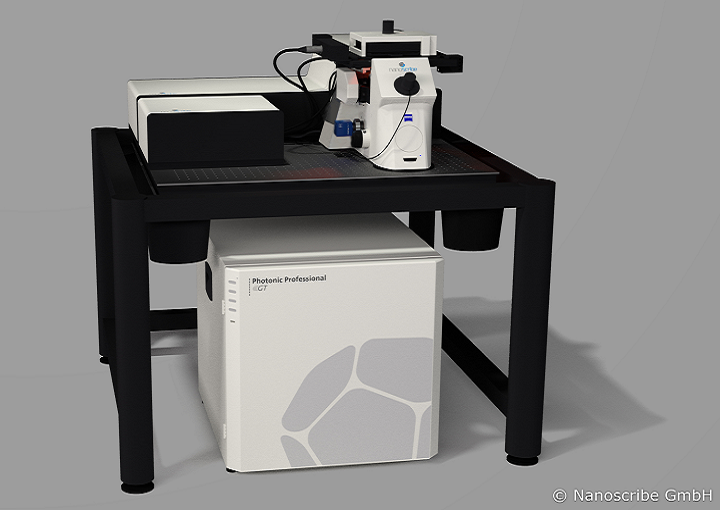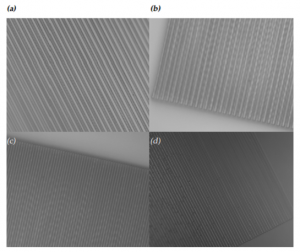Student Uses Nanoscribe Technology to Investigate 3D Printed Microstructures for Optics in Thesis
German 3D printer manufacturer Nanoscribe specializes in 3D micro and nano printing, and its Photonic Professional GT 3D printer, which uses a two-photon polymerization process, was used in two life sciences studies this year that show the true practicality of 3D printed micro-objects. For simple designs, Nanoscribe’s technology can fabricate structures with features even smaller than a micron on the 300 nm scale.
Two years ago, Leiden University in the Netherlands purchased a Nanoscribe 3D printer, which the university’s Quantum Optics department is currently interested in using to create and investigate complex optical 3D structures. This makes it necessary to look into any existing issues with using Nanoscribe’s technology to 3D print optical objects.
 Leiden student Evert Stolte recently completed a thesis, titled “Characterisation of 3D-printed micro-structures for optics,” for a Bachelor of Science degree in Physics. Stolte’s thesis, which was supervised by Martin van Exter, investigated 3D printing optical micro-structures with the university’s Nanoscribe 3D printer.
Leiden student Evert Stolte recently completed a thesis, titled “Characterisation of 3D-printed micro-structures for optics,” for a Bachelor of Science degree in Physics. Stolte’s thesis, which was supervised by Martin van Exter, investigated 3D printing optical micro-structures with the university’s Nanoscribe 3D printer.
The abstract reads, “This research explores the possibility of producing acrylic micro-structures for optical purposes with a Nanoscribe 3D-printer, which uses two-photon polymerisation. More specifically, it tries to characterise the effect of inherent flaws of the 3D-printing production method on far-field transmission optics. The studied samples are gratings with different periodicities ranging from 4 to 1 mm and samples with flat and tilted surfaces. The gratings show optical effects from variations in displacement, duty-cycle and height, and scattering effects from writing lines. Steps are taken towards 3D-printing multi-grating layer samples, with the end goal of producing a woodpile structure and other multi-layer photonic crystals.”
The primary goal of Stolte’s research was to characterize the possible band limitations, for optical purposes, of structures 3D printed using Nanoscribe’s technology, beginning with flat surfaces and gratings, such as those consisting of parallel bars.
“Especially for larger, more mesoscopic structures, parts may be flat. However, this can be problematic because of the discrete nature of 3D-printing,” Stolte wrote.
The thesis also notes that the more “interesting structures” will have multiple layers of gratings.
According to the paper, “One optical multi-layer periodic structure that is of particular interest is the ‘woodpile’ crystal: Layers of parallel bars on top of each other, turned 90° every other layer like stacked wooden logs. This structure has been made and researched in the past, because of it’s optical band gap properties and relatively simple manufacture method of stacking thin bars. The wood pile has also been produced with similar photon polymerisation methods and used for multiple purposes. However, with the Nanoscribe, we see an opportunity to modify this structure. Instead of a 90° difference between layers, a crystal with another angle can be made with the Nanoscribe. This twisted woodpile has different transmissions in right- and left-handed polarised light.”
According to a paper published last year about the use of 3D woodpile photonic crystals for visible light applications, photonic crystals are structures with a periodically modulated refractive index.
In addition to modifying the woodpile crystal structure, Stolte also looked into unintended scattering from surface roughness, as well as the nonconformity effect “between intended and produced structure on the optical far field diffraction pattern.”
The research also took steps to both produce, and research, transmissions of 3D optical periodic structures, such as the twisted woodpile one.
Stolte concludes, “With the exploration of 3D-printing in one layer gratings done in this research, future research should focus more on stacking the gratings.”
You can read Stolte’s full thesis here.
Discuss this and other 3D printing topics at 3DPrintBoard.com or share your thoughts in the comments below.
Subscribe to Our Email Newsletter
Stay up-to-date on all the latest news from the 3D printing industry and receive information and offers from third party vendors.
Print Services
You May Also Like
3D Printing Financials: Prodways Ends 2024 with a Profit
After a tough couple of years, Prodways (EPA: PWG) is starting to bounce back. The French 3D printing company finally made a profit in 2024, improved its operating performance, and...
Blue Origin & Auburn University Use EOS M290 to Study Copper 3D Printing
Blue Origin, the commercial space company built off of investments from Amazon founder Jeff Bezos, has donated two EOS M290 powder bed fusion (PBF) printers to Auburn University’s National Center...
Rocket Lab to Acquire Restructured Laser Communications Provider Mynaric AG
Rocket Lab USA, the Long Beach-based, end-to-end space services company that specializes in producing rockets with additive manufacturing (AM), has announced plans to acquire Mynaric AG, a German provider laser...
3D Printing Financials: Stratasys Ends 2024 with Cost Cuts and Growth Plans
Stratasys (Nasdaq: SSYS) has wrapped up 2024 with stronger margins but a full-year net loss. The polymer 3D printing leader navigated a year of economic headwinds, restructuring efforts, and shifting...






























